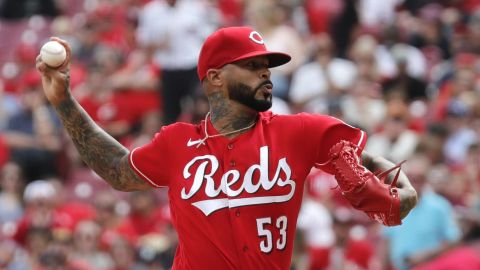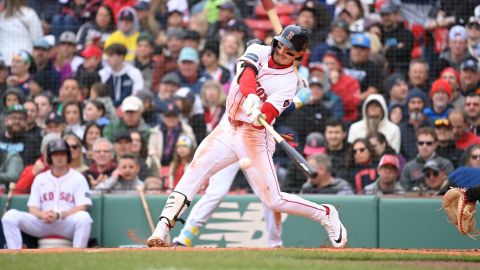Why Red Sox Offensive Breakout Could Be Coming After Slow Start
Boston should eventually start hitting with RISP
“Timing is everything” might be an overused cliché in the real world, but it’s so often true in the world of baseball. Getting a hit with runners in scoring position can turn a one-run loss into a one-run win.
In baseball betting, timing is important, too. Latching onto a team just before a winning streak or starting to fade a team just before a losing streak can be very beneficial.
Last week, we saw some extremes regress to the mean. It seemed like the Dodgers were invincible, but they actually dropped four games in a row and were one strike away from getting swept by the Phillies for a fifth straight loss. We also saw the lowly Tigers sweep the Orioles and even the Reds win a few games in a row.
It’s too bad many of us didn’t see those things coming, but timing is everything.
Let’s see if we can time up some positive and negative regression for this week and beyond.
Team Regression
Positive: Boston Red Sox offense
From one Sox last week to another this week. The Red Sox are 22nd in runs scored per game but have the seventh-most plate appearances with runners in scoring position. The chances have been there but have gone by the wayside. Of the top nine teams in plate appearances with RISP, the Red Sox are the only one batting below .256 (.232).
The Red Sox’s .251 batting average on balls in play (BABIP) in that split actually rose by almost 20 points on their road trip to Atlanta and Texas, which could be an indicator of how much the cooler weather at Fenway Park has been stifling offense. Still, the Red Sox rank 22nd in wOBA on the road, so this has been an issue across all venues.
Better plate discipline would help generate even more opportunities with RISP, as the Red Sox have the league’s highest swing percentage and second-lowest walk percentage. With the drop in offensive production due to the deadened baseball across MLB, this has been a bad season for being aggressive so far. If nothing else, the Red Sox are in line for better fortunes in high-leverage plate appearances and should see an uptick in runs moving forward.
Negative: Milwaukee Brewers offense
I have to preface this by saying I love what the Brewers are doing. In the previous five seasons, their fly-ball percentage (FB%) had a range from 32.3% to 35.9%. This season, they lead the league at 40.8%.
The Brewers, however, are second in baseball in home run-to-flyball rate at 13.9%, trailing only the Yankees. This is not a team with a lot of traditional power hitters, so that seems like an early-season outlier, not to mention American Family Field has been a pitcher’s park in recent years. The Brewers rank 15th in road SLG, so the majority of the damage is being done at home. Their home SLG of .474 is 17 points higher than any other team.
Eighteen of Milwaukee’s 36 games entering Tuesday were against the Cubs, Pirates and Reds, so they’ve faced some bad pitching. While the shift in philosophy could allow the Brewers to continue hitting for power, some regression, specifically at home, is very likely.
Player Regression
Positive: Yusei Kikuchi (Toronto Blue Jays)
Kikuchi made his seventh start of the season Monday night and it came against his former team, the Mariners. Kikuchi has faced the Yankees three times, the Astros twice and the Red Sox once. His 3.38 ERA is rather impressive given all of the hard contact he has allowed. Entering his excellent start Monday, half of the balls in play against Kikuchi were hit at least 95 mph.
The Yankees lead the league in hard-hit percentage, the Astros are fifth, the Red Sox are about league average and the Mariners rank near the bottom. The Red Sox are the only below-average lineup Kikuchi has faced.
If Kikuchi stays healthy and everything stays on track, his next starts line up against the Reds, Angels, Twins and Tigers — two bad offenses, one good one and one excellent one. That’s an easier run than facing the Yankees and Astros in five of seven starts, and he should have a chance to impress, much like his six shutout innings against the Mariners.
Negative: Dakota Hudson (St. Louis Cardinals)
I feel like I say this about Hudson at some point every season, but the numbers paint an ugly picture of what’s to come. Hudson has a 3.06 ERA over 35.1 innings, but his seven starts have featured some hideous strikeout and walk rates, and his advanced metrics suggest negative regression is on the way.
Hudson has a 5.38 xERA with a 5.06 FIP. His 82.9% left-on-base percentage and his .248 BABIP against are two strong indicators of why he has a 3.06 ERA, but also why maintaining such a low number looks unsustainable. Hudson’s K% is down to a career-low 13.5% and his BB% is up to 11.5%, similar to the mark he had in 2019 when he had a 3.35 ERA with a 4.93 FIP over 174.2 innings.
The big difference this season is he’s allowing a lot more hard contact. His 46.8% Hard Hit% and 9.2% Barrel% are both career-worst numbers, but he’s managed to pitch around them. Hudson is slated to pitch against the Mets, then either the Blue Jays or Brewers, and then the Padres. I’ll be looking to go against him in some or all of those starts.
For more sports betting information and analysis, visit VSiN.com.



